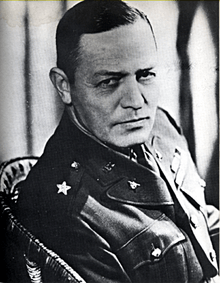Edwin L. Sibert
| Edwin Luther Sibert | |
|---|---|
 March 2, 1897 | |
| Born |
March 2, 1897 Little Rock, Arkansas |
| Died |
December 16, 1977 (aged 80) McLean, Virginia |
| Buried at | Arlington National Cemetery |
| Allegiance |
|
| Service/branch |
|
| Years of service | 1918–1954 |
| Rank |
|
| Commands held |
Department of the Antilles OP4 Commander Operation PORTREX |
| Awards |
Distinguished Service Medal (3) Legion of Merit Bronze Star Medal |
| Relations |
MG William L. Sibert, father MG Franklin C. Sibert, brother Lt. Cmdr. Edwin L Sibert, Jr,. son Dr. Edwin L. Sibert, III, grandson (chemist) |
Edwin Luther Sibert (1897–1977) was a United States Army officer with the rank of Major General and served as intelligence officer during World War II and post-war Europe where he assisted in the creation of the Gehlen Organization.[1] He would return to the United States and briefly serve in the Central Intelligence Group, the forerunner of the modern CIA. He was the son of Major General William L. Sibert and the brother of Major General Franklin C. Sibert. A graduate of the United States Military Academy in 1918, he would receive the Distinguished Service Cross three times for his service during World War II and the Cold War.[2][3]
Early years
Sibert was born on March 2, 1897, in Little Rock, Arkansas, to Major General William L. Sibert and his wife Mary Margaret Cummings Sibert. He would be raised on military tradition, his grandfather William J. Sibert and great-uncle William B. Beeson having served in the Confederate Army, and his father in the United States Army.[4] Sibert's early years would see his father assigned to Manila, Philippines (1899–1900), and the Panama Canal Zone (1907–1914).[5] In 1914, Sibert would receive an at-large appointment to the United States Military Academy graduating in 1918.[6]
Promotions
| Rank | Date |
|---|---|
| 12 June 1918 | |
| 23 October 1918 | |
| 16 August 1919 | |
| 1 August 1933 | |
| 1 April 1940 | |
| 15 January 1941 | |
| 12 June 1941 | |
| 1 February 1942 | |
| 4 August 1942 | |
| 31 October 1942 | |
| 11 March 1948 | |
| 31 October 1942 | |
| 1 August 1948 | |
| 21 March 1953 |
Service
| Beginning | Ending | Assignment |
|---|---|---|
| July 1940 | December 1941 | U.S. Military Attaché to Brazil |
| December 1941 | March 1942 | Assistant Secretary, Combined Chiefs of Staff |
| March 1942 | May 1942 | Attending Field Artillery School, Ft. Sill, Oklahoma |
| May 1942 | August 1942 | Chief of Staff, 7th Division |
| August 1942 | August 1943 | Commanding Officer, Artillery, 99th Division |
| September 1943 | March 1944 | Assistant Chief of Staff (G2)European Theater of Operations |
| March 1944 | July 1945 | Assistant Chief of Staff (G2), 12th Army Group |
| July 1945 | September 1946 | Assistant Chief of Staff (G2)European Theater of Operations |
| September 1946 | 12 August 1948 | Assistant Director of Operations, Central Intelligence Group (CIA) |
| 13 August 1948 | 23 November 1948 | Commanding General, Pacific Sector, Panama Canal Zone |
| 24 November 1948 | December 7, 1950 | Commanding General, U.S. Army Forces, Department of Antilles |
| December 7, 1950 | April 24, 1952 | Staff Director, Inter-American Defense Board, Washington, D.C. |
| April 24, 1952 | Commanding Officer, Camp Edwards, Barnstable County, Massachusetts |
Decorations
Here is the ribbon bar of Major General Edwin L. Sibert:
References
- ↑ Selby, Andrew Scott. The Axmann Conspiracy: The Nazi Plan for a Fourth Reich and How the U.S. Army Defeated It. New York: Penguin, 2012.
- ↑ http://projects.militarytimes.com/citations-medals-awards/recipient.php?recipientid=100398
- ↑ http://www.arlingtoncemetery.net/elsibert.htm
- ↑ Beeson, Henry Hart. "A Genealogy of the Beeson-Beason Family." Houston, Texas: H. H. Beeson, 1968.
- ↑ MG William L. Sibert, Biography, Chemical Corps Regimental Association, http://www.chemical-corps.org/honors/sibertbio.htm
- 1 2 3 Official U.S. Army Register 1954, Washington, D.C.: Department of the Army, 1954.
- ↑ Ruffner, Kevin C., ed. Forging An Intelligence Partnership: CIA and the Origins of the BND 1945-1949: A Documentary History, Vol. I, CIA History Staff, Center for the Study of Intelligence, 1999.